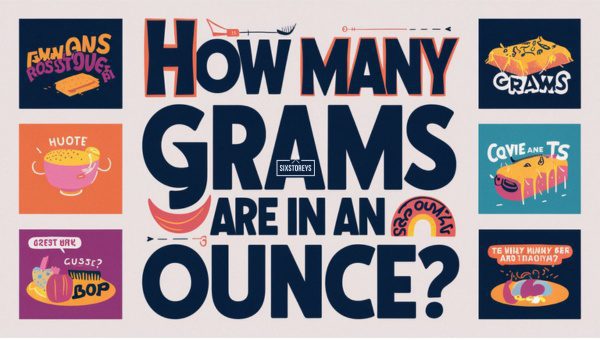How Many Grams Are In An Ounce? Quick and Easy Guide
Ever found yourself in the middle of cooking your favorite recipe, only to stumble upon a measurement that has you scratching your head? I know I have. You’re in the flow, chopping, mixing, and then—bam—you're asked to add an ounce of an ingredient. But wait, your kitchen scale only measures in grams!
That's when the crucial question hits: how many grams in an ounce? Knowing this little conversion can be a lifesaver, whether you’re whipping up something delicious in the kitchen, managing your weight-lifting routine, or even dealing with medications. In this post, I'll guide you through everything you need to know about converting ounces to grams and why it's so important to get it right. Grab your measuring tools, and let's dive into the world of weight conversions!

Also Read: How Many Ounces Are in a Pound?
Article Includes
How Many Grams Are In An Ounce?
When it comes to weight conversions, the metric and imperial systems often leave people puzzled. Simply put, 1 ounce is equal to 28.35 grams. This conversion is vital for anyone moving between recipes, shopping lists, or even exercise plans that use different measurement systems. Whether you're measuring out ingredients for a recipe or weighing a parcel to ship internationally, knowing this conversion can save you a lot of hassle.
Picture this: You're baking a classic American apple pie. The recipe calls for 4 ounces of sugar, but your European friend only has a scale that measures in grams. No worries! With a quick calculation (4 ounces multiplied by 28.35 grams per ounce), you can tell your friend to use 113.4 grams of sugar.
Why Understanding Weight Conversions Is Important?
The Culinary Realm
Understanding weight conversions is especially crucial in the kitchen. Ingredients measured incorrectly can lead to disastrous culinary results. Imagine putting in too much baking powder because you couldn't convert ounces to grams correctly; your cake could end up bitter or collapsed. Consistency and precision are key to replicating a perfect dish each time.
Medicine And Health
Beyond the kitchen, weight conversions play a significant role in the medical field. Prescriptions often require dosages to be measured in grams or milligrams. Misunderstanding these conversions could lead to under or overdosing, which can have severe consequences on your health. Precise measurements ensure that you get the right amount of medication.
Trade And Commerce
International trade also depends heavily on accurate weight conversions. When businesses import or export goods, they often deal with different measurement systems. Knowing how to convert measurements correctly ensures fair trade practices and prevents potential financial losses. It’s essential for maintaining healthy business relationships and keeping transactions transparent.
Fitness And Nutrition
For fitness enthusiasts, understanding weight conversions can mean the difference between meeting your nutritional goals or missing the mark. Nutritional labels might display information in grams, but your dietary plan might list daily intake in ounces. Isn’t it easier to stick to your diet plan when you don’t have to second-guess every measurement?
Easy Reference Table
Still confused? Here’s a quick reference table to simplify things:
| Ounces (oz) | Grams (g) |
|---|---|
| 1 | 28.35 |
| 2 | 56.70 |
| 3 | 85.05 |
| 4 | 113.40 |
| 5 | 141.75 |
The Science Behind Grams and Ounces
Understanding the science behind grams and ounces can be quite fascinating. A gram is a metric unit of mass, originating from the Latin word "gramma," which means "small weight." One gram is defined as one-thousandth of a kilogram, which is the base unit of mass in the International System of Units (SI). On the flip side, an ounce comes from the Imperial system and is used primarily in the United States and a few other countries.
Historical Insights
The ounce harks back to ancient Rome, where it was called "uncia" and used to measure both volume and weight. Grams, however, have a more modern concoction, tied closely with the advent of the metric system during the French Revolution. Grasping these historical roots can help demystify why different parts of the world prefer one system over the other.
Measurement Accuracy
Grams tend to offer more precision, especially for scientific calculations and culinary needs where exact measurements are crucial. One ounce is roughly equal to 28.35 grams, making it a bulkier unit that's perhaps more intuitive for everyday, less critical measurements.
Practical Uses of Grams and Ounces in Daily Life
Cooking and Baking
One of the most common scenarios where weight conversion becomes necessary is in the kitchen. Many online recipes might list ingredients in ounces, while your local recipe book uses grams. Here, knowing that 1 ounce equals roughly 28.35 grams can save you a lot of guesswork.
Shopping
Next time you're at the grocery store evaluating packaging, you'll find that products often list weights in both grams and ounces. This dual labeling can help you make smarter purchasing decisions.
Healthcare
Accurate weight conversion is also essential in medicine. Whether you're measuring out a precise dose of medication or monitoring your nutrient intake, understanding how many grams are in an ounce is crucial.
Easy Tricks to Remember Conversions
Mnemonic Devices
Mnemonics can be handy. Think of it this way: "An ounce on the scale is about 30 grams, just a little extra to make your cooking grand." It's not exact, but it's close enough to jog your memory in a pinch.
Use a Digital Scale
A digital kitchen scale that measures both grams and ounces can make your life simpler. This tool takes the guesswork out of conversion, allowing you to switch between units instantly. Many modern scales have a toggle button to shift between grams and ounces, making them convenient for any recipe.
Online Conversion Tools
When all else fails, various websites can do the math for you. Bookmark a reliable conversion tool, or use one of many apps available for smartphones.
Common Confusions and How to Avoid Them?
Weight conversions can be tricky, especially if you’re juggling between the metric and imperial systems. One common confusion is assuming that ounces and fluid ounces are the same. While an ounce measures weight, a fluid ounce measures volume. Mixing these two up can lead to incorrect measurements and, ultimately, unsatisfactory results. Another frequent mistake people make is rounding off weight conversions too much—for example, assuming that 1 ounce equals 30 grams when it’s actually 28.35 grams. This may seem small, but those few grams can make a significant difference in precision.
Tips to Avoid Common Mistakes:
- Double-Check Measurements: Always double-check your conversions to ensure accuracy.
- Use Reliable Sources: Opt for trusted sources or conversion tools to avoid incorrect results.
- Understand the Context: Make sure you're aware of whether the recipe or task is referring to weight (ounces) or volume (fluid ounces).
Tools and Apps for Accurate Conversions
In today’s digital age, there’s no reason to struggle with weight conversions. Several tools and apps are designed to make your life easier by doing the math for you.
Digital Scales
A digital kitchen scale that measures both grams and ounces can be a game-changer. These scales often come with a simple switch that allows you to toggle between the two units.
Conversion Apps
Smartphone apps are incredibly convenient for quick conversions on the go. Some popular options include:
- Kitchen Scale Converter
- Convert Units
Online Calculators
There are also numerous online calculators that can provide instant conversions:
- RapidTables: Provides quick conversions with an easy-to-use interface Visit RapidTables
- Convert-me: Another reliable resource for all sorts of unit conversions Visit Convert-me
Also Read: How many Ounces in a Gallon?
Frequently Asked Questions
How Many Grams are in a Half-Ounce?
A half-ounce is equivalent to approximately 14.17 grams.
Are Grams and Ounces Used the Same Way in Recipes?
Recipes from different regions often use various measurement systems. For instance, American recipes frequently use ounces, while European recipes lean towards grams. A good recipe will often provide both measurements, making it accessible to a global audience.
Can I Use a Fluid Ounce to Gram Converter for Solids?
No, fluid ounces measure volume, not weight. Always use weight-specific measures like grams and ounces for precise culinary success.
How Precise Do My Measurements Need to Be?
The level of precision required can vary based on the task. Baking, for instance, often requires more precise measurements than something like a stew. When in doubt, aim for accuracy to avoid any mishaps.
Conclusion
Mastering the conversion from ounces to grams can simplify many aspects of our daily lives. Whether you're perfecting a recipe, tweaking your workout regimen, or handling any task that requires precise measurements, knowing that one ounce equals approximately 28.35 grams can make a world of difference.
Confidence in these conversions not only saves time but also ensures accuracy, making your efforts more effective and enjoyable. Keeping a handy conversion tool or a dual-unit scale can ease the process even further. As you gain more practice and become familiar with these measures, you'll find that navigating between grams and ounces becomes second nature. Happy measuring!
